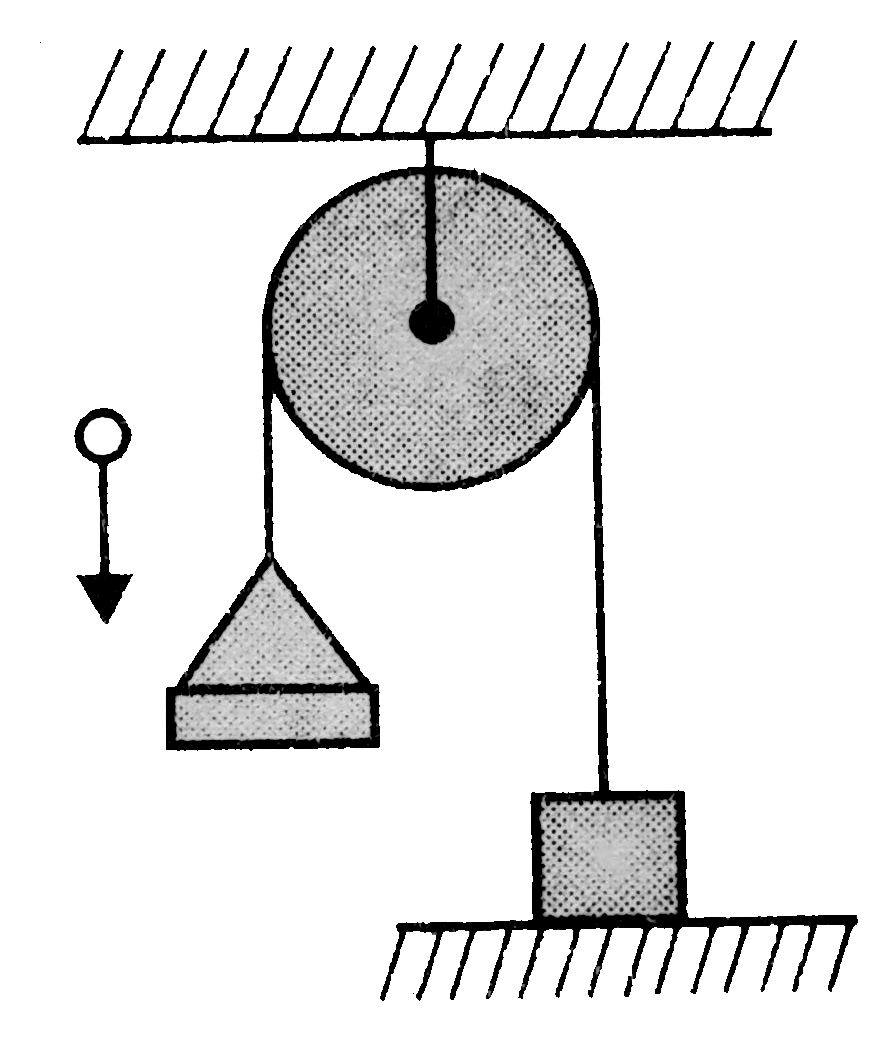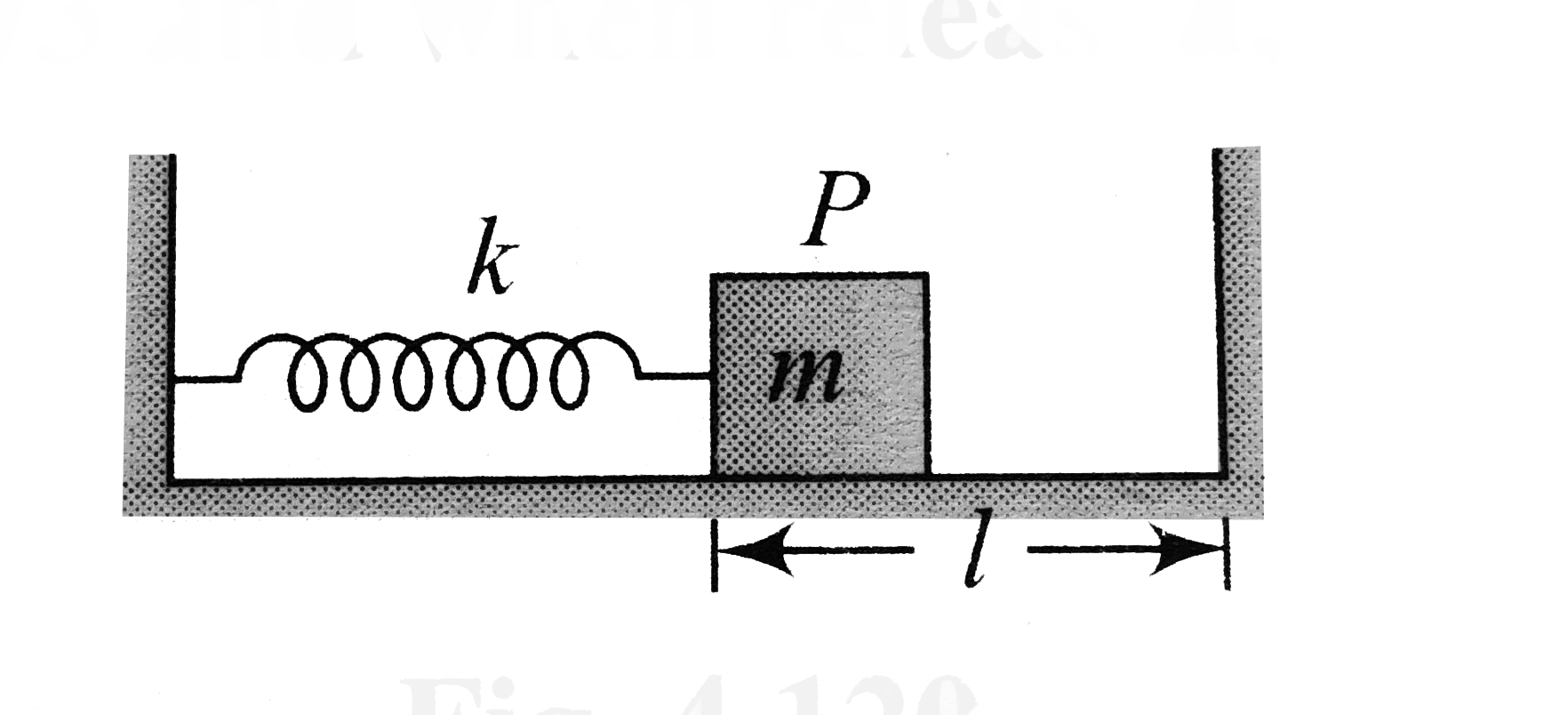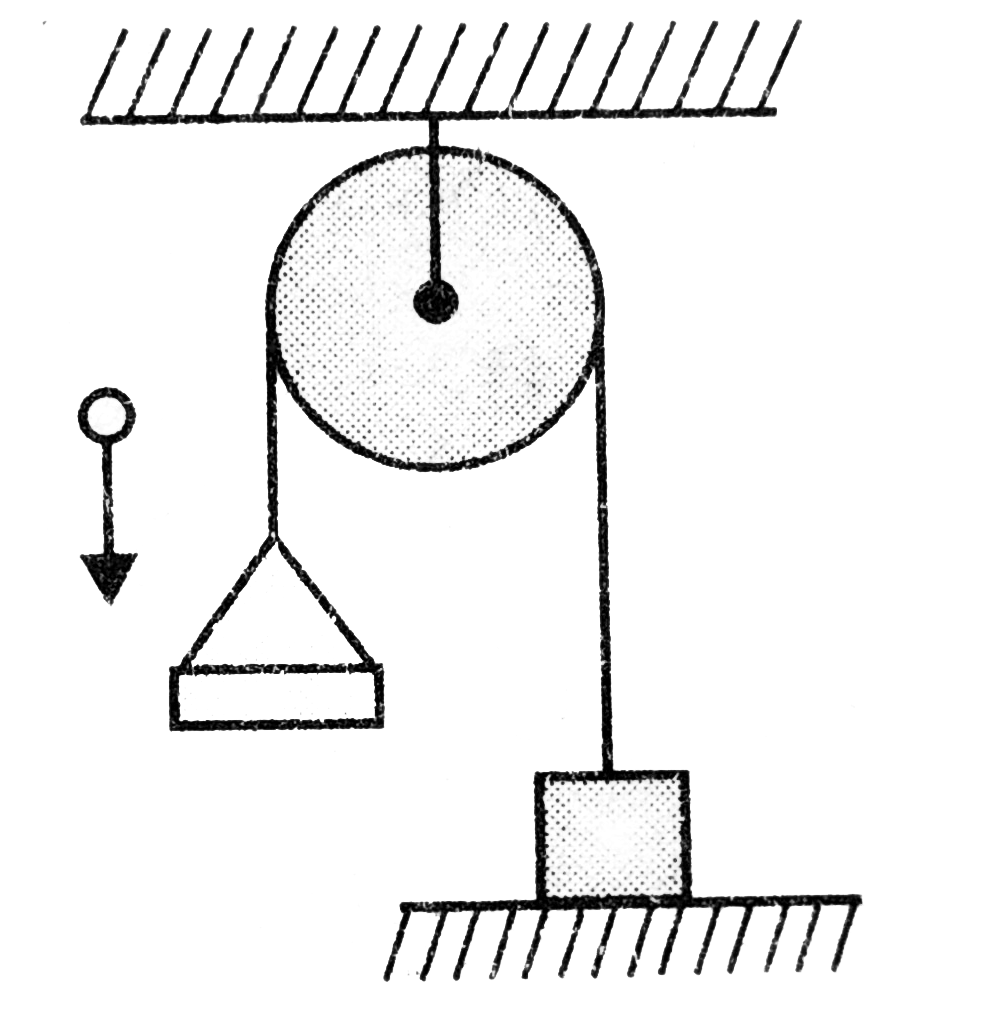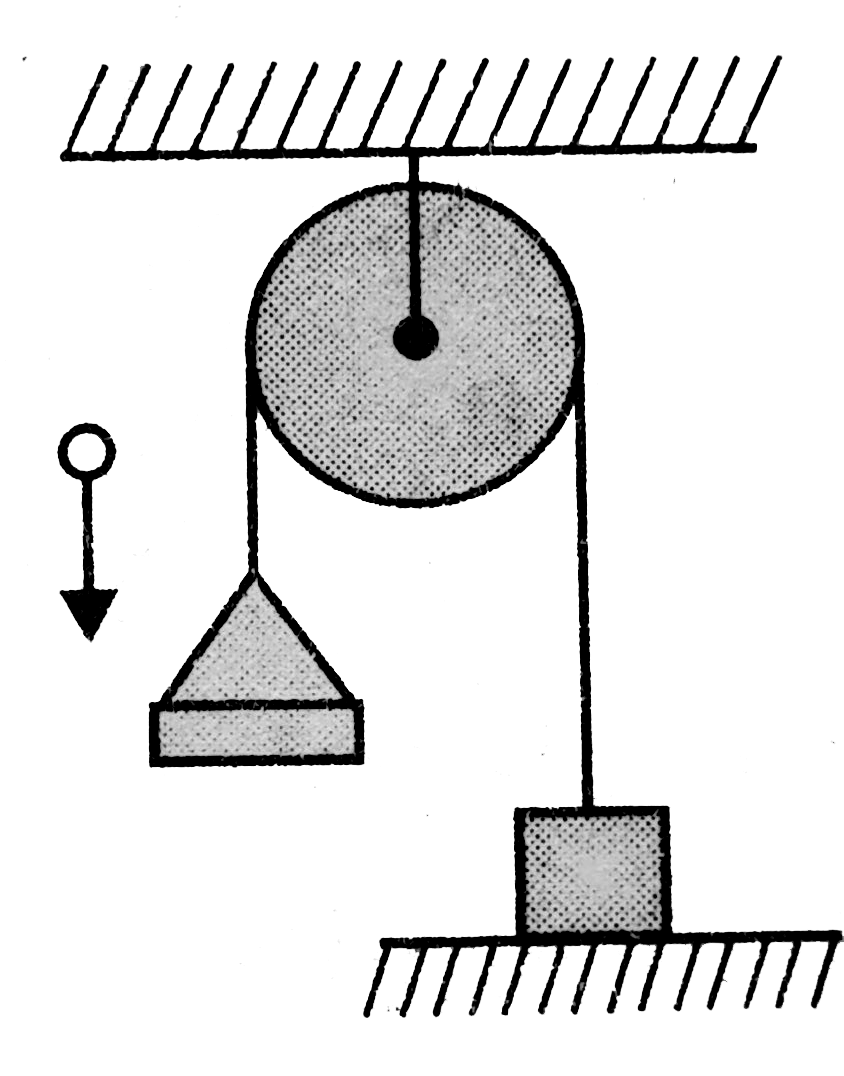Consider a gravity free hall in which an experimenter of mass 50 kg is resting on a 5 kg pillow, 8 ft above the floor of the hall. He pushes the pillow down so that it starts falling at a speed of 8 ft/s. The pillow makes a perfectly elastic collision with the floor, rebounds and reaches the experimenter\'s head. Find the time elapsed in the process.
2.2 s
1.1 s
4.4 s
3.3 s
The correct Answer is:A
To solve the problem step by step, we will analyze the motion of the pillow and the experimenter, taking into account the elastic collision and the distances involved.
Step 1: Understand the Initial Conditions
The experimenter has a mass of 50 kg and is resting on a pillow of mass 5 kg. The pillow is initially at a height of 8 ft above the floor and is pushed down with an initial speed of 8 ft/s.
Step 2: Calculate the Time Taken for the Pillow to Hit the Floor
The pillow is falling under the influence of gravity-free conditions, so we will consider its initial velocity and the distance it travels.
- Initial velocity (u) of the pillow = 8 ft/s (downward)
- Distance (h) to the floor = 8 ft
Using the equation of motion:
h=ut+12at2
Since there is no gravity, the acceleration a=0:
8=8t
Solving for t:
t1=88=1 second
Step 3: Determine the Pillow's Rebound Velocity
Since the collision with the floor is perfectly elastic, the pillow will rebound with the same speed it hit the floor, which is 8 ft/s (upward).
Step 4: Calculate the Height from the Pillow to the Experimenter's Head
After the pillow rebounds, it will travel upward to the experimenter's head. The distance from the pillow to the experimenter's head is the initial height plus the distance the pillow fell:
H=8 ft (height to floor)+0.8 ft (height moved by experimenter)=8.8 ft
Step 5: Calculate the Relative Velocity After the Rebound
The experimenter moves upward with a velocity of 0.8 ft/s (as calculated from the downward motion of the pillow). The relative velocity of the pillow after the rebound with respect to the experimenter is:
vrelative=vpillow−vexperimenter=8 ft/s−0.8 ft/s=7.2 ft/s
Step 6: Calculate the Time Taken for the Pillow to Reach the Experimenter's Head
Using the distance and the relative velocity, we can find the time taken for the pillow to reach the experimenter's head:
t2=Hvrelative=8.8 ft7.2 ft/s
Calculating t2:
t2≈1.22 seconds
Step 7: Calculate the Total Time Elapsed
The total time elapsed is the sum of the time taken for the pillow to hit the floor and the time taken for it to reach the experimenter's head:
ttotal=t1+t2=1 second+1.22 seconds=2.22 seconds
Final Answer
The total time elapsed in the process is 2.22 seconds.
---
The experimenter has a mass of 50 kg and is resting on a pillow of mass 5 kg. The pillow is initially at a height of 8 ft above the floor and is pushed down with an initial speed of 8 ft/s.
The pillow is falling under the influence of gravity-free conditions, so we will consider its initial velocity and the distance it travels.
- Distance (h) to the floor = 8 ft
h=ut+12at2
Since there is no gravity, the acceleration a=0:
8=8t
Solving for t:
t1=88=1 second
Since the collision with the floor is perfectly elastic, the pillow will rebound with the same speed it hit the floor, which is 8 ft/s (upward).
After the pillow rebounds, it will travel upward to the experimenter's head. The distance from the pillow to the experimenter's head is the initial height plus the distance the pillow fell:
H=8 ft (height to floor)+0.8 ft (height moved by experimenter)=8.8 ft
The experimenter moves upward with a velocity of 0.8 ft/s (as calculated from the downward motion of the pillow). The relative velocity of the pillow after the rebound with respect to the experimenter is:
vrelative=vpillow−vexperimenter=8 ft/s−0.8 ft/s=7.2 ft/s
Using the distance and the relative velocity, we can find the time taken for the pillow to reach the experimenter's head:
t2=Hvrelative=8.8 ft7.2 ft/s
Calculating t2:
t2≈1.22 seconds
The total time elapsed is the sum of the time taken for the pillow to hit the floor and the time taken for it to reach the experimenter's head:
ttotal=t1+t2=1 second+1.22 seconds=2.22 seconds
The total time elapsed in the process is 2.22 seconds.
Topper's Solved these Questions
- BOOK - RESONANCE ENGLISHCHAPTER - DAILY PRACTICE PROBLEMEXERCISE - DPP No.608videos
DAILY PRACTICE PROBLEM
- BOOK - RESONANCE ENGLISHCHAPTER - DAILY PRACTICE PROBLEMEXERCISE - DPP No.6120videos
DAILY PRACTICE PROBLEM
- BOOK - RESONANCE ENGLISHCHAPTER - DAILY PRACTICE PROBLEMEXERCISE - DPP No.5820videos
DAILY PRACTICE PROBLEM
- BOOK - RESONANCE ENGLISHCHAPTER - CURRENT ELECTRICITYEXERCISE - High Level Problems (HIP)19videos
CURRENT ELECTRICITY
- BOOK - RESONANCE ENGLISHCHAPTER - ELECTRO MAGNETIC WAVESEXERCISE - Exercise 327videos
ELECTRO MAGNETIC WAVES
Similar Questions
A man of 50kg mass is standing in a gravity free space at a height of 10m above the floor. He throws a stone of 0.5kg mass downwards with a speed 2m/s. When the stone reaches the floor, the distance of the man above the floor will be
View SolutionA man of 50kg mass is standing in a gravity free space at a height of 10m above the floor. He throws a stone of 0.5kg mass downwards with a speed 2m/s. When the stone reaches the floor, the distance of the man above the floor will be
View SolutionA pan of mass m=1.5kg and a block of mass M=3kg are connected to each other by a light inextensible string, passing over a light pulley as shown in Fig. Initially, the block is resting on a horizontal floor. A ball of mass m0=0.5kg collides with the pan at a speed v0=20m/s. Consider this instant of collision as t=0. Assume collision to be perfectly inelastic. Now, Fig. answer the following questions based on the above information.

Find the time t at which the block strikes the floor for the first timeView SolutionFigure shown a block P of mass m resting on a smooth horizontal surface, attached to a spring of force constant k which is rigidly fixed on the wall on left side, shown in the figure . At a distance l to the right of the block there is a rigid wall. If block is pushed towards left so that spring is compressed by a distance 5l/3 and when released, if will starts its oscillations. If collision of block with the wall is considered to be perfectly elastic. Find the time period of oscillation of the block.
 View Solution
View SolutionA pan of mass m=1.5kg and a block of mass M=3kg are connected to each other by a light inextensible string, passing over a light pulley as shown in Fig. Initially, the block is resting on a horizontal floor. A ball of mass m0=0.5kg collides with the pan at a speed v0=20m/s. Consider this instant of collision as t=0. Assume collision to be perfectly inelastic. Now, Fig. answer the following questions based on the above information.

Find the velocity of pan + ball system at t=2.6s. Assume that the block comes to rest instantaneously after striking the floor.View SolutionA 2kg mass is attached to a spring of force constant 600N/m and rests on a smooth horizontal surface. A second mass of 1kg slides along the surface toward the first at 6m/s.
(a) Find the amplitude of oscillation if the masses make a perfectly inelastic collision and remain together on the spring. what is the period of oscillation ?
(b) Find the amplitude and period of oscillation if the collision is perfectly elastic.
( c) For each case , write down the position x as a function of time t for the mass attached to the spring, assuming that the collision occurs at time t=0. What is the impulse given to the 2kg mass in each case ?View SolutionA pan of mass m=1.5kg and a block of mass M=3kg are connected to each other by a light inextensible string, passing over a light pulley as shown in Fig. Initially, the block is resting on a horizontal floor. A ball of mass m0=0.5kg collides with the pan at a speed v0=20m/s. Consider this instant of collision as t=0. Assume collision to be perfectly inelastic. Now, Fig. answer the following questions based on the above information.

Mark the correct statement(s) for this situationView SolutionAn inquistive student, determined to test the law of gravity for himself, walks to the top of a building og 145 floors, with every floor of height 4 m, having a stopwatch in his hand (the first floor is at a height of 4 m from the ground level). From there he jumps off with negligible speed and hence starts rolling freely. A rocketeer arrives at the scene 5 s later and dives off from the top of the building to save the student. The rocketeer leaves the roof with an initial downward speed v0. In order to catch the student at a sufficiently great height above ground so that the rocketeer and the student slow down and arrive at the ground with zero velocity. The upward acceleration that accomplishes this is provided by rocketeer's jet pack, which he turns on just as he catches the student, before the rocketeer is in free fall. To prevent any discomfort to the student, the magnitude of the acceleration of the rocketeer and the student as they move downward together should not exceed 5 g.
Just as the student starts his free fall, he presses the button of the stopwatch. When he reaches at the top of 100th floor, he has observed the reading of stopwatch as 00:00:06:00. What should be the initial downward speed of the rocketeer so that he catches the student at the top of 100 the floor for safe landing ?View SolutionAn inquistive student, determined to test the law of gravity for himself, walks to the top of a building og 145 floors, with every floor of height 4 m, having a stopwatch in his hand (the first floor is at a height of 4 m from the ground level). From there he jumps off with negligible speed and hence starts rolling freely. A rocketeer arrives at the scene 5 s later and dives off from the top of the building to save the student. The rocketeer leaves the roof with an initial downward speed v0. In order to catch the student at a sufficiently great height above ground so that the rocketeer and the student slow down and arrive at the ground with zero velocity. The upward acceleration that accomplishes this is provided by rocketeer's jet pack, which he turns on just as he catches the student, before the rocketeer is in free fall. To prevent any discomfort to the student, the magnitude of the acceleration of the rocketeer and the student as they move downward together should not exceed 5 g.
Just as the student starts his free fall, he presses the button of the stopwatch. When he reaches at the top of 100th floor, he has observed the reading of stopwatch as 00:00:06:00 (hh:mm:ss:100 th part of the second). Find the value of g. (correct upt ot two decimal places).View SolutionAn inquistive student, determined to test the law of gravity for himself, walks to the top of a building og 145 floors, with every floor of height 4 m, having a stopwatch in his hand (the first floor is at a height of 4 m from the ground level). From there he jumps off with negligible speed and hence starts rolling freely. A rocketeer arrives at the scene 5 s later and dives off from the top of the building to save the student. The rocketeer leaves the roof with an initial downward speed v0. In order to catch the student at a sufficiently great height above ground so that the rocketeer and the student slow down and arrive at the ground with zero velocity. The upward acceleration that accomplishes this is provided by rocketeer's jet pack, which he turns on just as he catches the student, before the rocketeer is in free fall. To prevent any discomfort to the student, the magnitude of the acceleration of the rocketeer and the student as they move downward together should not exceed 5 g.
The correct velocity - time graph for the rocketeer would beView Solution

